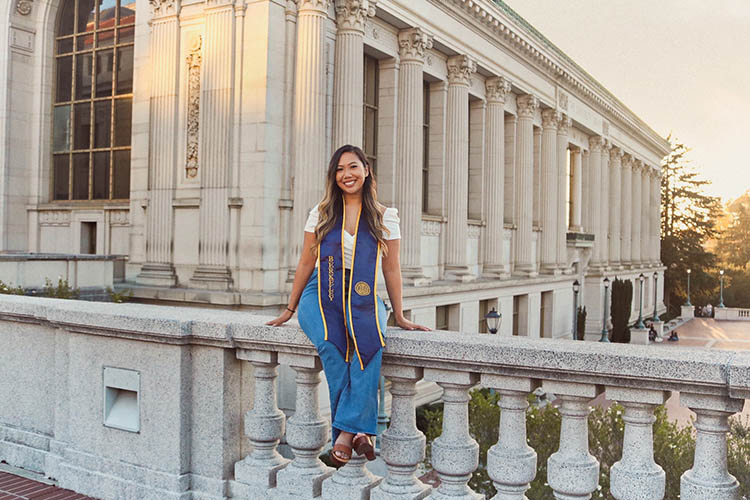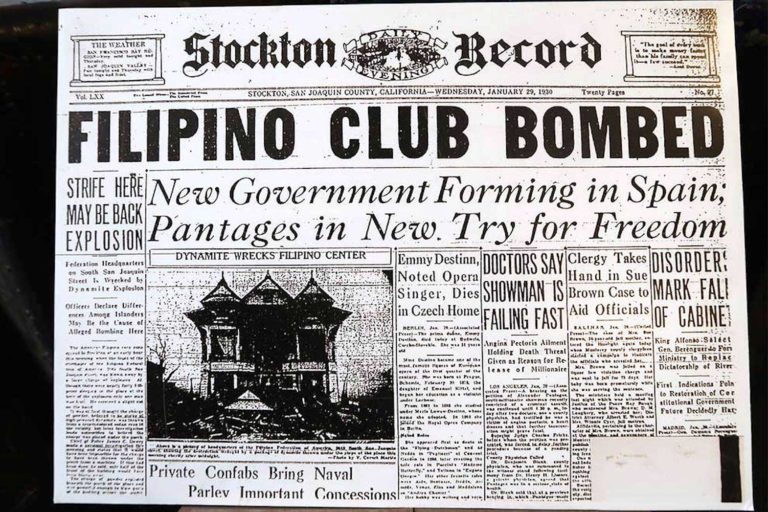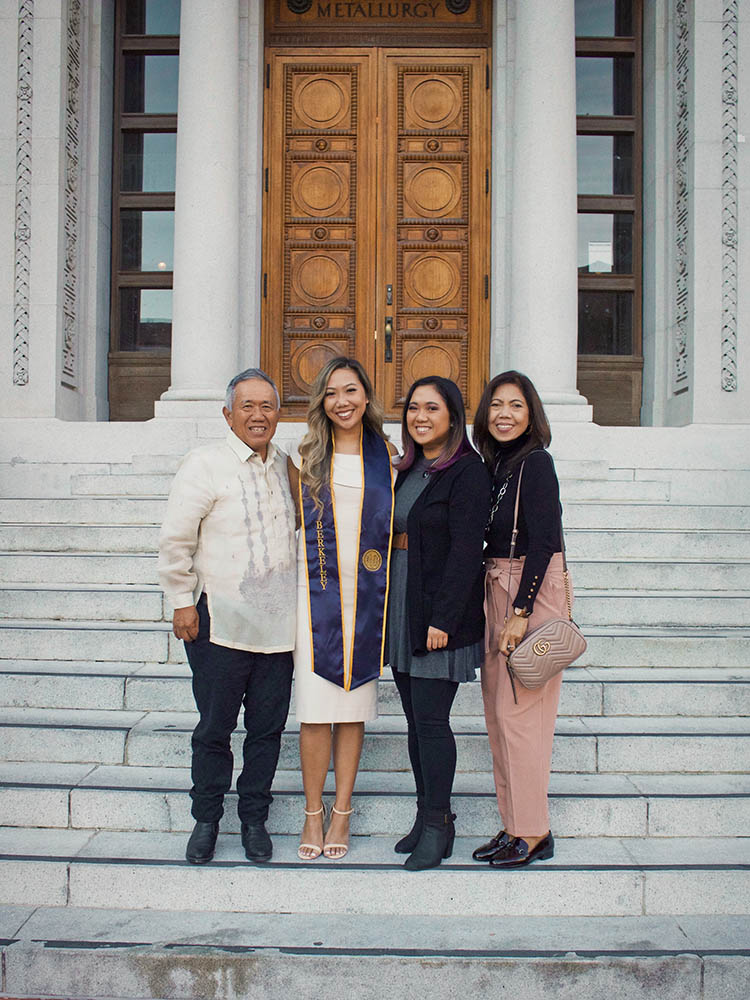I’m A Berkeleyan: Student Katalina Cortez on finding her cultural identity to pay it forward
The graduating senior plans to go back to her hometown of Watsonville to mentor the next generation of Filipinx American students
December 18, 2020

Katalina Cortez graduates this week after transferring to UC Berkeley two years ago. “The Filipinx community actually welcomed me with open arms here. I felt like I belonged somewhere, and it has made me comfortable with being Filipinx American.” (Photo courtesy of Katalina Cortez)
This I’m A Berkeleyan feature was written as a first-person narrative from an interview with Katalina Cortez. Have someone you think we should write about? Contact [email protected].
I was raised in Watsonville, California. It’s a small city on the central coast near Santa Cruz that has a big agricultural industry: Driscoll’s, Martinelli’s: Every berry you could think of are picked from those fields.
My dad is from the Philippines, but as a military brat, he left around the age of 11 to live in America. After his father, my grandfather, retired from the U.S. Army, my dad and his four siblings worked in the strawberry and raspberry fields, and apple orchards of Watsonville.
From elementary school through high school they worked to help support their parents.
When my dad got older, he went back to his hometown in the Philippines, a province called Candon in the Ilocos region of Luzon. He met my mom, who lived in the same baryo — that’s a Tagalog word meaning village. They fell in love and got married. After my sister was born, my dad moved them all back to Watsonville, where I was born.
Growing up, my dad worked as a janitor for Calabasas Elementary School. He worked there until his retirement 10 years ago. My mom is a nurse and has worked at the Watsonville Community Hospital for nearly 20 years.

Cortez, left, performing gymnastics with her childhood best friends at the Filipino Community of Watsonville. The hall was a place for her to connect with her Filipinx culture at a young age. (Photo courtesy of Katalina Cortez)
In Watsonville, there aren’t many Filipino residents, but there is a Filipino community hall where potlucks and tight-knit community get-togethers are held every month.
I remember going to the parties as a kid where my dad would barbecue the chicken, and they would serve Filipinx foods, like lechon (crispy-roasted pig), for us to eat. There would be music and a dance floor where everyone had fun line dancing. All of the aunties — in Filipinx culture, anyone who is an older woman and knows your parents is considered your ‘auntie’ — would sit around a table and talk about the latest community chismis (Tagalog for gossip).
As a kid, I knew I was Filipino American, but I wasn’t really exposed to the culture other than that.
When I was 5, a doctor told my parents that I had a speech impediment, and that I wasn’t speaking English correctly. The doctor told them not to speak to me in Tagalog or Ilocano (the native dialect of their province in the Philippines) anymore, because it would ‘confuse me’ as a child.
The only time I would hear my parents speak their native language after that was when they were on the phone or when they talked to each other. I was also placed in these speech classes, which was weird, because I was the only kid that had to go to them.
I have a childhood friend that always tells me that when we were kids, I would talk to her mom in Tagalog whenever I would come over to their house: I don’t remember that at all.

Cortez, right, took her first trip to the Philippines as a young child. Here, she is pictured with her cousins and sister. “I would be ashamed that I wasn’t Filipino enough. I didn’t speak the language, I didn’t eat the food, and because I was so different, I didn’t think they liked me.” (Photo courtesy of Katalina Cortez)
In our neighborhood, there is a large Mexican and Latinx community, and a lot of them were my neighbors and friends growing up. I was really exposed to their cultures. I remember hanging out with my neighbors as a kid, and when we were hungry, their abuelita (an affectionate term in Spanish for grandmother) would bring out tacos, quesadillas and this flower cake that was my favorite.
I even learned to speak a little Spanish.
Everyone treated me like I was Filipino, but I would still get people saying , ‘Oh, you’re Chinese, but you’re Brown? That doesn’t make sense.’
But going to the local public schools, I feel like everyone was really nice to me, everyone was cool with me being Filipino — with me being different. I was so integrated into Mexican culture other students would say, ‘Oh, she’s cool. She understands us.’ It was a really welcoming environment, there was nothing really hostile about it.
My sophomore year of high school, I switched to a private school that was predominately white: That change really made me hate being Brown.
White students from Santa Cruz went to the school and did not like Asians from San Jose. I wasn’t from San Jose, but they assumed all Asian students were, and they would call them ‘valleys,’ short for Silicon Valley, which has a large population of Asians. I once had a lady in Santa Cruz yell at me to, ‘Go back to the valley!’
Throughout high school, I never told people I was Filipino.

In high school, Cortez, center, danced hula and embraced other forms of Hawaiian culture because she was ashamed of her Filipinx heritage. “I literally put so much energy into assimilating to whatever culture was around me and what everyone wanted me to be,” she recalls. (Photo courtesy of Katalina Cortez)
I had relatives from Hawaii, so I pretended to be Hawaiian because other students thought that was different, in a cool way. They thought I was exotic and more interesting. I stopped going to the Filipino community hall in Watsonville, and I didn’t want to associate myself with Filipinos anymore.
I learned how to speak pidgin, dance hula and how to sing in and understand Hawaiian while playing ukulele. I literally put so much energy into assimilating to whatever culture was around me and what everyone wanted me to be.
There were times where I didn’t want to bring my parents to school because my mom’s accent would expose that I wasn’t Hawaiian.
It was a really bad identity crisis.
After high school, I went to De Anza College in Cupertino, where things really began to open up for me. I forced myself to accept my true cultural identity.

Cortez’s best friends from De Anza college visited her at Berkeley’s campus after she transferred in fall 2018. (Photo courtesy of Katalina Cortez)
I joined the Asian Pacific American Leadership Institution and LEAD Filipino, a group that looks to increase Filipinx American engagement in policy advocacy. I was exposed to a bigger Filipinx community at De Anza, and when I transferred to UC Berkeley in fall 2018, I built a community of Filipinx friends by dancing in the Pilipino Cultural Night group.
I also took Filipinx American and Asian American history courses that opened my eyes to history that I didn’t know existed.
Farmworkers from the very fields my family had picked produce from were part of the United Farm Workers movement with Cesar Chavez and Filipinx American activists Larry Itliong and Philip Vera Cruz.
I realized the stories my father told me as a child about anti-Filipino riots in Watsonville were actually true — I started to ask him more about it.
Although he was born in the 1950s, my dad became friends with a lot of the manongs (Ilocano for older Filipinx man or relative) that were alive during the riots in January 1930, when hundreds of white men in Watsonville were angry at Filipino men who were immigrating to the United States, accusing them of taking their jobs and taking their women to dance halls in Watsonville’s Filipino neighborhoods.
So, the white men took to the streets and began beating and terrorizing Filipinos and shooting at them, even killing one Filipino man, Fermin Tobera. Those riots eventually began to spread throughout California, and it was basically in pure hatred against Filipinos.
My dad said my great uncle was one of the farm workers who was terrorized by some white men who called him a ‘brown monkey’ and beat him with a rock, causing him to lose sight in one of his eyes.

The anti-Filipino riots in 1930 are a part of American history that Cortez said she never learned about in detail until she was an adult. “Why was the only thing that I learned in high school that was related to Asians about Pearl Harbor?” (Photo courtesy of Filipino American National Historical Society)
Learning this history and finding out how close to home it hit, I had questions: Why didn’t I learn this in my high school history books? Why are Filpinos never integrated into American history?
Just knowing that Filipinx Americans have done so much for this country, and we’re still treated like this, and barely given any recognition, I was very irritated and angry. With that knowledge, at Berkeley, I decided to major in interdisciplinary studies.
I basically made my own major, where I chose to intertwine psychology, sociology and ethnic studies. All the things I’m really interested in. My thesis revolves around the study of unconscious racial bias in the hiring process.
This interests me because I think racism in America pressures people of color not to identify with our native ethnicities, and instead to assimilate into American culture and American ideas of what is accepted in society.
Throughout my own life, I was surrounded by so many white and Latinx people from such a young age, whether it be through my neighborhood or school, and I created this internal hatred of being Filipinx American. But now, as I think about it more, it wasn’t just me creating this hatred — it was definitely the lack of representation and lack of Filipinx culture present within my environment.
After I graduate this winter, I’m really looking into going into diversity and inclusion work, and through my thesis, I’ve concluded that the lack of representation of communities of color in history books, in media or in certain school and work environments, contributes to an unconscious racial bias that creates racial disparities in employment opportunities and beyond.

Last year, Cortez joined Berkeley’s Pilipinx Cultural Night where she said she found a sense of belonging with the campus’s Filipinx community. Here she poses with the group before performing a traditional dance from the Philippines southern island, Mindanao. (Photo courtesy of Katalina Cortez)
Moreover, I think that the contributions, culture and history of these communities not only need to be included in our history books, but those communities need to be recognized.
In November, after 90 years, the Watsonville city council issued a formal apology to Filipinx and Filipinx American members of the community for the 1930 race riots. There was talk of a plaque or a street or school being named in honor of the Filipinx community in Watsonville.
I think more should be done.
That’s why I attended the city council meeting last month to tell them they would be wasting their money on those things. Why not give the Filipinx community the money so we can do something to better preserve our history for future generations?
They could reallocate the funds somewhere else, like a scholarship program, so the Filipino community hall doesn’t have to hold small fundraisers for Filipinx American students that are college bound.
How are we going to send these kids to college through barbecue chicken fundraisers?
The rate of kids going to college in Watsonville is just so low. And as someone who grew up there, I know there aren’t a lot of examples of Filipinx American students that are going to colleges and universities.
That’s why, after I graduate, I want to eventually go back home to Watsonville and create a youth program at the Filipino community hall to prepare kids for higher education. I want to help in sending them to community colleges and universities.

To celebrate her graduation, Cortez’s family poses with her on campus. She credits her mother and father for all the sacrifices they made to give her the academic opportunities she has had throughout her life. (Photo courtesy of Katalina Cortez)
That’s my goal in life right now, because I just love the kids of the Filipino community of Watsonville. I think it’s important to guide the next generation to go to college, because it gives them access to a lot of different resources that we don’t have in Watsonville and could even be a pathway for them to see the world.
I want these students to have the opportunities that I have had and more.
My time at Berkeley made me so proud to be Filipinx American. The Filipinx community actually welcomed me with open arms here. I felt like I belonged somewhere, and it has made me comfortable with being Filipinx American.
Finding my identity is still ongoing. There are still some times that I struggle to fully embrace myself since I don’t speak the language and I don’t know all the history, but I’m finally at a place now where I can say who I actually am. My experiences are valid as a 2nd generation Filipino American.